Hola and welcome to Where on Planet Earth! In case you got here by accident and are not yet a subscriber, sign up below! For more visuals on our travels follow us on IG @whereonplanetearth
You might have noticed I skipped the usual journal post last week. It’s the first week that I don’t publish since I started doing so weekly five and a half months ago. Honestly, I beat myself up for thinking about skipping it, then for actually skipping it, and then for beating myself about it in the first place. A vicious cycle, those I so often fall for. The truth is that life happens, and I haven’t had much time except to live it and be present. So it might be a week late, but my heart is on the page, as usual.
My dad, Alan, and I just finished walking El Camino de Santiago (The Way of St James), a very long walk in the fields, forests, and towns of Galicia in northwestern Spain. There are many Caminos - pilgrim ways dating back to the Middle Ages - all leading to the Cathedral of Santiago de Compostela, where the shrine of the apostle Saint James the Great is located (this is debated though, but that is a story for another day). Although religious in origin, with time and fame the Camino has transformed, and now hundreds of thousands walk the Camino every year for all sort of reasons.
Ours was not a religious reason. It was about fulfilling a dream. You see, my dad lived many years of his childhood in Galicia, where my grandma was from. Those years defined him, made him who he is today, like places sometimes do. Like Caracas, where I was born and raised, College Station, where life took me for a wild ride, and Seattle, where I got to know and love myself, were completely defining to me.
My dad had wanted to walk the camino for years; as a statement to the place that gave him so much, as a challenge to himself both physically and mentally, as a way to spend time with me, his only daughter. Maybe there are other reasons too. All I know is that my reasons were his.
So together we embarked in the 116km six day journey from Sarria to Santiago de Compostela, and what a lovely long walk it was. The first day was a taste of what we would encounter throughout: colorful fields, tall trees, good food, and happy animals.


Here is what stood out from each day:
Day 1
We took our time, as there was no reason to rush. We had many miles ahead of us, but nothing else in the agenda except to walk. This is one of the reasons why I love multi-day hiking so much: the simplicity of it. You know what you have to do today: walk; you know what you have to do tomorrow: walk. It’s so beautifully simple.
As it’s customary, we said “buen camino”/ “good way” to the people we passed or passed us along the way; to the Spanish, Ecuadorian, Dutch, American, and all other pilgrims, to the old and the young, to the energetic and the easygoing, to those with a destination in mind and those with the way as the destination. The vibe was jovial, happy, peaceful. The weather was that perfect hiking temperature, not too hot not too cold. We walked through many small towns now living off agriculture, cattle, and pilgrims. We stopped in one to have serrano ham, local cheese, and wine under the sun. This was a different kind of hiking no doubt, and I could get used to it.

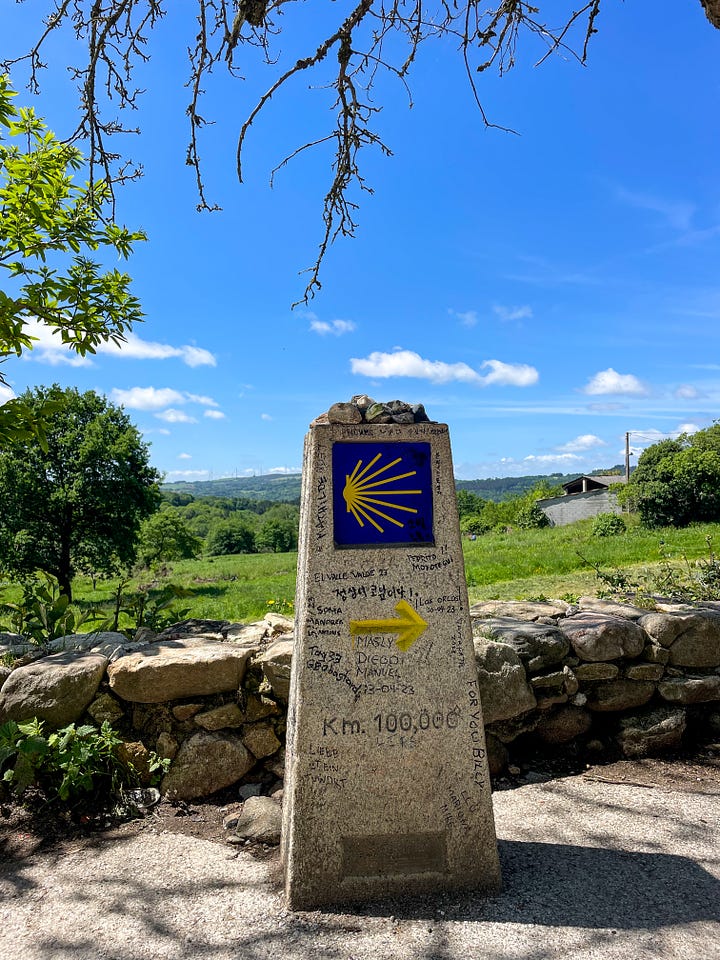
That night we slept in Portomarin, my favorite town in the entire Camino. It’s up the flanks of the Miño river, now wide and deep though not even 70 years ago it was narrower and next to a medieval town that was submerged under water after a dam was constructed nearby. Our hotel host shared the story of her grandfather who lived in Portomarin then; “My grandpa's house didn’t end up underwater, but all his good land did”. The government paid those whose houses and land were submerged, either with an apartment in the new town up the mountain, or in cash. With little good land left many took money the government paid them and went elsewhere, but her father stayed, and used the money to lent it to others while charging some interest. He made a life there, and now his family lives off the tourism the Camino brings. We learned of many stories like this, of multi generational families that continue to live in these small towns mostly because of the Camino. This trotted path is old, it has been walked by millions for at least a thousand years, and you can feel this as you arrive in these towns that have welcomed, feed, and sheltered foreign people since as long as they have existed. It’s a special thing to be part of.


Day 2
The day started in a misty forest straight out of a fairy tale; spooky and mysterious. Long tree branches pierced thought the thick myst, leaves danced in the soft wind, birds chirped all around us. The mist lifted once the sun started warming up, and then it was bright green fields painted in white, purple, and yellow flowers. We passed a dozen cows and as many calfs lazily grazing and scratching themselves with loggs.
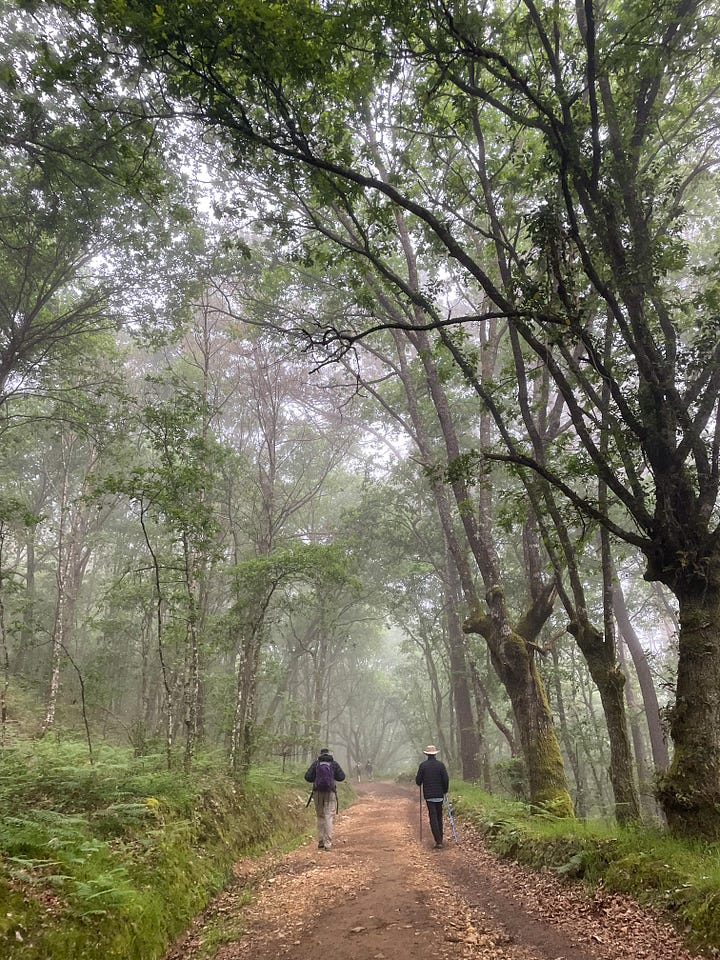

My dad struggle with the long 25km that day, but we all made it to Palas de Rei, and looking for a change from the typical Spanish meals we stumble into a tiny place we thought was Italian. As we entered it, a peculiar accent greeted us; it only takes a word for a Venezuelan to recognize another Venezuelan. We ended up chatting with the owners, Dani and Alex, for a long time while eating arepas (not in the menu!) and drinking Venezuelan rum. So much of the beauty of el Camino was how full of surprises it was.


Day 3
The sun hid under dark clouds and created a moody ambience. The green tunnels persisted, one of my favorite features of the Camino, as did the fields of flowers and the rose bushes climbing the walls of houses. Even walking in the light rain was pleasant, the sound of it falling on leaves meditative. The hike itself was not physically challenging, but it was without a doubt stimulating; there was always something to see, to feel, to think through, to discuss.
This is another reason why I love hiking so much: when I hike I allow my mind to wander, which is not something I do often. I allow myself to think of everything and nothing, and it’s as clarifying as it’s confusing (in the most wonderful way). I have had the most insightful self-discoveries while hiking, and Alan and I have had the deepest of conversations and have made many life changing decisions under tree canopies while climbing mountains. What a joy it’s to wander, physically and mentally.


We had plenty of time to wander around Melide that evening, our destination for the night. We found a bowling alley in town and didn’t hesitate to play a round. Afterwards we kept wandering and ran into a man playing his gaita (bagpipe). He was next to a small church on the highest hill of town, playing in a corner sort of facing the wall, I suppose for the sound to reverberate. He was alone in a non touristy area, just practicing. The three of us sat in a little wooden bench admiring the view over green fields and pretty little houses while storks flew by to their giant nests and their storks chicks, and puffy white clouds adorned the blue sky. With the gaita sounds all around us I felt time stood still.
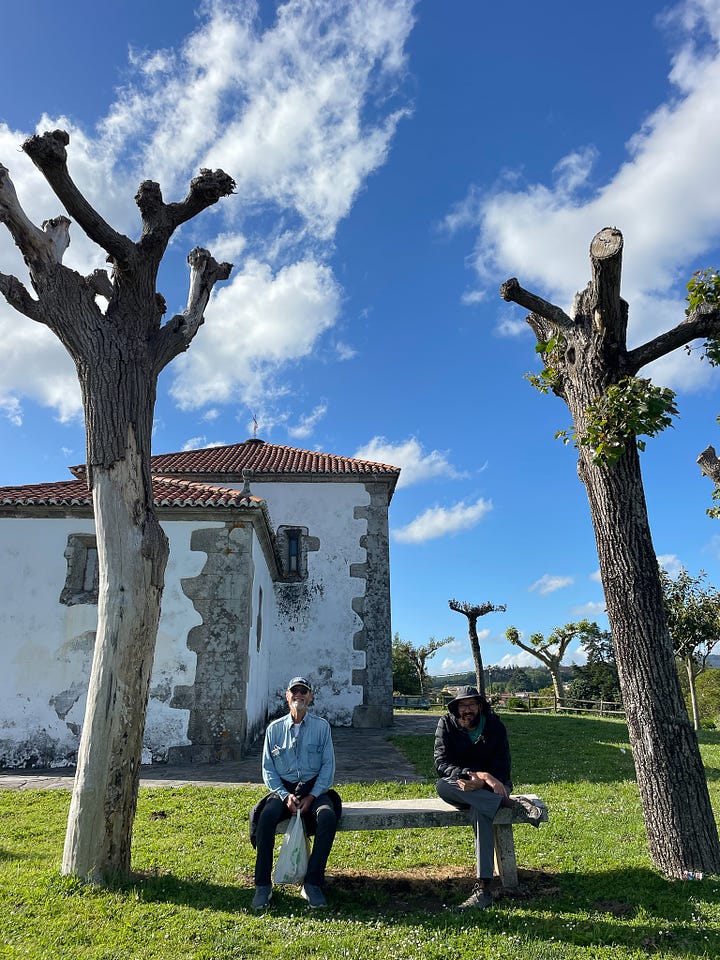

That evening we dined in one of the famous pulperías of Melide, and had one of the best meals of the trip served by a Cuban and prepared by a Colombian. We latin folks are everywhere and I freaking love it. The octopus was perfectly cooked, drizzled with olive oil and spicy paprika, and we dipped crusty warm bread in that mix until there wasn’t a single drop left.
Truthfully, the Camino was as much about food as it was about walking. We ate - and drank - so well and so fresh every single day. My dad said that if he walked the Camino for a month (which many people do) he would end up gaining weight, and I don’t think that is far from the truth. Each little town has its specialty; octopus in Melide, cheese in Arzua, good and cheap wine everywhere. Even water costs more than wine sometimes, so the decision is always easy. Albariño all day every day for me, thank you very much.






Day 4
The fourth day was pretty suave; the route was gentle, going up and and down in soothing waves. Just enough to get your heart pumping but not to make you sweat intensely. The most eventful part of the day was stopping for lunch 3km before getting to our destination in a pretty place run by an old bitter lady who fought every customer for one thing or the other. A special character. The moment I went into the restaurant she was bickering about women going into the men’s restroom, “Estas se quieren meter en el de los hombres!” / “These women want to go into the men’s restrooms!”. This - going into the men’s restroom - is something I often do if there is a line in the women’s one, which is common and still a mystery to me (what are you all doing in there?). And, anyways, we shouldn’t even have gendered bathrooms, this is 2023! The old woman continued to get progressively angrier for various small and insignificant situations, such as someone asking for a a second fork - “ya te di uno! y esa comida no se comparte!” / “I already gave you a fork! and that food is not for sharing”. We stayed out of her way , but watched her every move as if in a theater.
The truth is that along the Camino most people were kind and understanding, but the bitter woman wasn’t the only impatient one. The Gallegos - people from Galicia - can be pretty stern and proud people. I suppose the amount of pilgrims going through their towns can make anyone a little insensitive.
I feel a lot of connection to Galicia, though it’s still far removed. Many of these towns along the Camino speak primarily Gallego, a language forbidden to be spoken for many decades when Franco was ruling Spain with an iron fist (the same was true of Catalan, the language they speak in Catalonia). Even though my dad lived in Galicia for 7 years when he was a kid, he doesn’t speak Gallego. Now, all kids in Galicia are taught the language in school and in many small towns it’s actually the most spoken language, even over Spanish which everyone speaks as well. I don’t speak Gallego nor Italian, even though I am both “by blood” (and Italian by passport). A child of immigrant families, an immigrant myself, we are from everywhere and nowhere, wouldn’t you say?

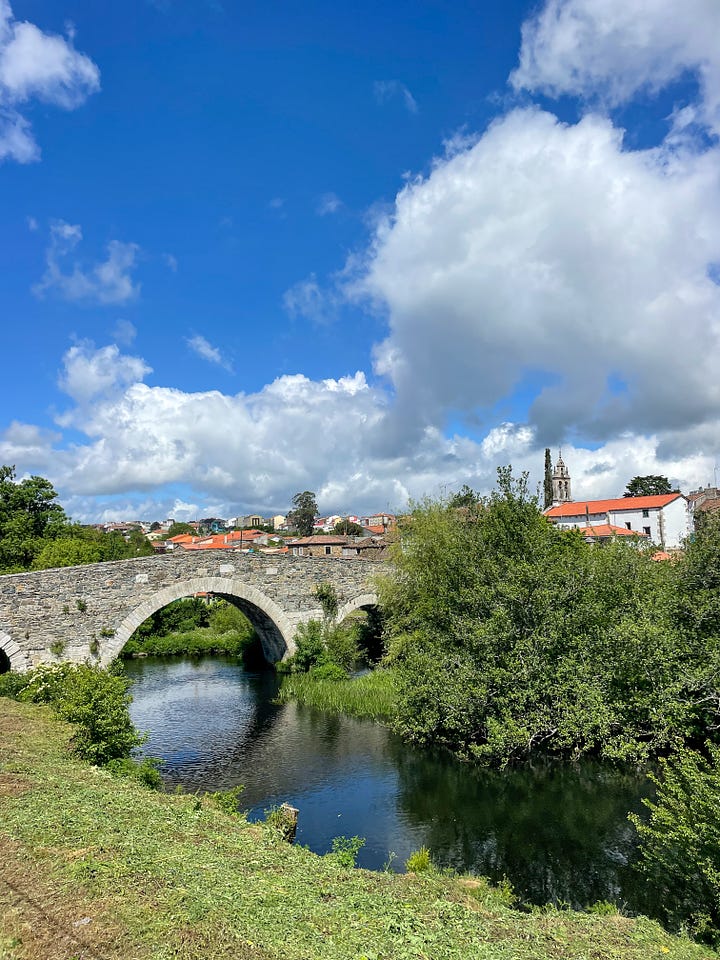


Day 5
By day five we got the hang of walking dozens of kilometers a day and arrived to the outskirts of O Pedrouzo super early. The rural house we were staying in had a nice pool so we sat under the sun while drinking vermouth with a splash of gin - my favorite Aperitive - and reading. At some point we decided to walk the two kilometers to town to find some dinner, which was again delicious. As we walked back to our place with full bellies and happy hearts I saw my dad eyeing a field of flowers and tall grass; “se ve comodo” / “looks comfy” he tells me and immediately kneels down to lay on it. I watched him while giggling and taking a video of him; he looked so content, so young and full of life. In that moment I saw myself clearly in him and laid down in the field, and looking at the wide blue sky next to my dad, I felt deep gratitude.


Day 6
The last day arrived, and the sun was shy but present. The early morning light hitting the tall ferns and purple flowers was magical. It rained, but only a bit, not enough to warrant the rain jacket except for just a few minutes. It was a pretty walk, like every other day; though forests, vibrant green tunnels, fields of flowers, under blue sky and grey sky and all the shades in between. We made sure to get our two “passport” stamps early in the walk. Many places along the way will have one out for you to stamp your own passport, the little book you buy at the beginning of the trek. Two stamps a day is what you need to prove you have in fact completed the trek to Santiago and receive your Compostela, the official accreditation of it.
When we arrived to Santiago we made our way through the narrow streets to the grand cathedral, the official end of the hike. We reached that monument erected hundreds of years ago following a path walked by millions in search of solitude, peace, forgiveness, faith. You don’t have to be religious for this moment to be special, and it was.

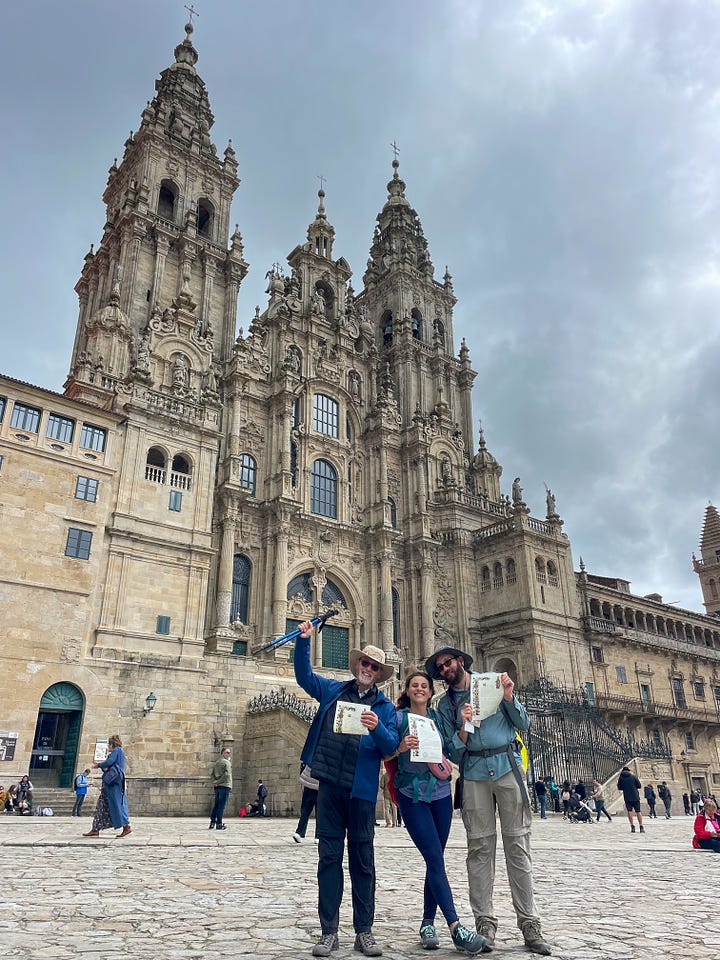
We celebrated with octopus, wine, and churros with chocolate, then made our way to our hotel to rest. Immediately I had a pit in my stomach, I was sad and confused. It was a bit of a surprise, but then again it wasn’t. Life for the previous six days had been reduced to essentials pieces; walk for miles, admire nature, eat nutritious meals, sleep like a log, and then do it all over again. As simple of a life as it can be, and I had deeply enjoyed it. It was also almost time to say goodbye to my parents, not knowing when I would see them again. And finally, we had fulfilled a dream; no one talks about how achieving something you have longed for can leave you feeling empty, as if the dream that you had inside is now no longer there and you need a new one to replace it.
But in the end, I knew this is not so hard to do. I just had to keep dreaming and start doing, and I have always been good at both. Besides, we had a celebratory dinner to go to, so off we when.






Getting to hike with one of your parents is a great experience. I backpacked from cascade pass to stehekin with my mom a few years ago and it is a memory I treasure